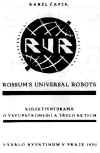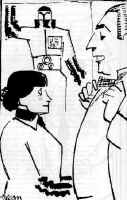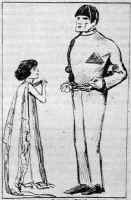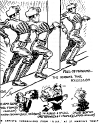R.U.R. (Rossum's Universal Robots)
RUR [ Intro & Summary | Image Archive | Review ]
 R.U.R. was written in
1920, premiered in Prague early in 1921, was performed in New York in
1922, and published in English translation in 1923. The following
year, G. B. Shaw and G. K. Chesterton were among those in London participating
in a public discussion of the play. Capek responded, via The
Saturday Review, to what he felt was the excessive thematic attention
they and other critics paid to one of his devices: "For myself, I
confess that as the author I was much more interested in men than in Robots."
[1]
R.U.R. was written in
1920, premiered in Prague early in 1921, was performed in New York in
1922, and published in English translation in 1923. The following
year, G. B. Shaw and G. K. Chesterton were among those in London participating
in a public discussion of the play. Capek responded, via The
Saturday Review, to what he felt was the excessive thematic attention
they and other critics paid to one of his devices: "For myself, I
confess that as the author I was much more interested in men than in Robots."
[1]
Virtually every encyclopedia or textbook etymology of the word "robot" mentions the play R.U.R. Although the immediate worldwide success of the play immediately popularized the word (supplanting the earlier "automaton"), it was actually not Karel Capek but his brother Josef, also a respected Czech writer, who coined the word. The Czech word robota means "drudgery" or "servitude"; a robotnik is a peasant or serf. Although the term today conjures up images of clanking metal contraptions, Capek's Robots (always capitalized) are more accurately the product of what we would now call genetic engineering. The play describes "kneading troughs" and "vats" for processing a chemical substitute for protoplasm, and a "stamping mill" for forming Robot bodies. A more imaginative and scientifically plausible description of the artificial creation of armies of workers would have to wait for Aldous Huxley's Brave New World (1932). [2]
The translator (Paul Selver) changed the play quite a bit while preparing the English version, combining two Robot characters into one, and considerably toning down the ending. If you're interested in reading the play as it was originally presented to American audiences, read the 1920s version (most university libraries will have a copy -- it was tremendously popular in its day).
In the 1990s, a new translation, with much better dialogue and a chilling new final speech (new to English audiences, anyway) by the Robot Damon, was published in a Capek reader called Toward the Radical Center (with a short introduction by Arthur Miller).
Plot Summary (spoilers)
Mass-produced by Robot-run assembly lines, Robots remember everything, and think of nothing new. According to Domin, "They'd make fine university professors." Rejecting Helena's theory that Robots have souls, the psychologist Hallemeier admits that once in a while, a Robot will throw down his work and start gnashing his teeth. The human managers treat such an event as evidence of a product defect, but Helena prefers to interpret it as a sign of the emerging soul.
 Domin
rather inexplicably asks Helena to marry him. She accepts, but continues
working to help the Robots by requesting that a scientist modify some
Robots, so that their souls might develop more fully. One
of the modified creatures is a Robotess, beautiful but useless.
The scientist speculates that if the Robotess (named after her spiritual
mother Helena) were to "wake up," she would hate him for making
her so beautiful, yet giving her a body that cannot know love or give
birth. The human Helena begins identifying with hothouse flowers
-- sterile because they are artificially cultivated, satisfying a consumer
demand that nature fulfills too slowly on her own. Meanwhile, human
fertility has been dropping worldwide; industrial civilization's drive
towards order and mechanization has made mankind superfluous.
Domin
rather inexplicably asks Helena to marry him. She accepts, but continues
working to help the Robots by requesting that a scientist modify some
Robots, so that their souls might develop more fully. One
of the modified creatures is a Robotess, beautiful but useless.
The scientist speculates that if the Robotess (named after her spiritual
mother Helena) were to "wake up," she would hate him for making
her so beautiful, yet giving her a body that cannot know love or give
birth. The human Helena begins identifying with hothouse flowers
-- sterile because they are artificially cultivated, satisfying a consumer
demand that nature fulfills too slowly on her own. Meanwhile, human
fertility has been dropping worldwide; industrial civilization's drive
towards order and mechanization has made mankind superfluous.
This dream, spoken by Damon (a demon?) echoes the dream of Domin (Dominus, the Lord?) -- both hope to use machinery to improve upon the work of nature. Without the all-important manuscript, however, the Robots discover "The only thing we cannot produce is Robots. The machines are turning out nothing but bloody chunks of meat." [3] They cajole, threaten and beg Alquist to help them discover what they call "the secret of life." In desperation, Damon offers himself up for study; screaming on the dissection table, he orders Alquist to continue the search.
Nature eventually re-emerges triumphant when two Robots (the beautiful but otherwise useless Helena, and Primus) fall in love. The play ends on an uplifting, religious note. Alquist blesses the lovers, renames them Adam and Eve, and sends them out to avoid the sins that destroyed their predecessors.
Links
- I Believe the Robots Are Our Future (satire)
- We Can Put a Man on the Moon, but We Can't Make Killer Robot Police? (satire)
Reciprocal Links (Archived)
I am no longer actively updating these links, but someone from the BBC's My Science Fiction Life contacted me and asked me for a link. The page she sent me taught me something I didn't know about RUR, so here's the link.
- Alpha Ralpha Boulevard. "Karel Capek." Alpha Ralpha Boulevard: Science Fiction Bibliographies <http://www.catch22.com/SF/ARB/SFC/Capek,Karel.php3>. Added Dec. 15, 1999.
- Anonymous Coward. "Re:Origin of "Robot" clarification - A bit more." [Comment appended by user to a slashdot posting by "JohnKatz".] Dec. 20, 1999. http://slashdot.org/features/99/12/12/1618253.shtml Added Dec 27, 2000.
- Artificial Intelligence Learning Group. "Robot links" [list of links] Institutt for datateknikk og informasjonsvitenskap. <http://www.ifi.ntnu.no/grupper/ai/eval/robot_links.html> Added Dec. 21, 2000.
- Bowser, Randy. "Word from the Director." Metropolis the Musical [Publicity website.] <http://rbowser.tripod.com/metropolis/directornotes.html> Added 22 May 2002.
- Blackstock, Jon. Suite101.com. "Hairy Ape Part 1." 23 Jun 2000. <http://www.suite101.com/article.cfm/dramaturgy/42754> Added 18 Sep 2000.
- Cooper, Charles. "Make that 'check', not 'checkmate'." C|Net. 10 May 2002. <http://news.com.com/2010-1074-909162.html> Added 13 Jun 2002.
- Currie, Adam. Adam's Robot Page. <http://cache.ucr.edu/~currie/roboadam.htm>. Added 14 Oct 1999.
- Dallas Personal Robotics Group. "Robotics Related Web Sites" [list of links] <http://www.dprg.org/links.html> Added Dec. 21, 2000.
- Fitton, Robert B. "Science Fiction... pump... a primer." The Fitton Chronicles [e-book author's website] <http://www.fittonbooks.com/pulp.htm>. Added 17 Feb 2002.
- Grupo de Robotica. [Organization home page.] December 20, 2000. Universitat de Lleida. http://robotica.udl.es Added Dec. 21, 2000.
- Grupo de Sistemas y Comunicaciones. "Introduccion." [Curricular site.] October 5, 2000. Departamento de Ciencias Experimentales e Ingeniería. Universidad Rey Juan Carlos. <http://gsyc.escet.urjc.es/docencia/asignaturas/robotica/transpas/node1.html> Added Dec. 21, 1999.
- Imaginautes.com. "Les réponses à la question 18." June 25, 2000. Imaginautes. <http://www.imaginautes.com/atelier/observatoire.php3?obs_mode=QUESTION&obs_ques=18> Added Dec. 15.
- Jerz, Dennis G. [Translator unknown.] "Le règne des robots." Le Encyclopedie de L'Agora. http://www.agora.qc.ca/reftext.nsf/Documents/Robot--Le_regne_des_robots_par_Karel_Capek Added Dec. 21, 2000.
- Jerz. Dennis G. "Capek's Dystopian Robots and O'Neill's Demonic Dynamo: The "Natural Man" in Technological Society" [Abstract of a conference paper.] 1996<http://www.chass.utoronto.ca/~djerz/rur-dyn.htm>
- Jones, Karl. "RUR or RU Not My Baby?" [personal web page ] June 2, 2000. Karl Jones web. <http://www.karljones.com/tech/robots/rur.asp> Added Dec. 27, 2000.
- K2robots.com. "Robot Stories." [List of links] 1999-2000. <http://www.k2robots.com/directory/RobotStories/RUR.htm> Added 21 Dec 1999.
- "Linkkejä tulevaisuusajattelun historian" [Unknown.] <http://users.utu.fi/helpaa/tulevaisuus.html> Added 27, 2000.
- Liukkonen, Petri. "Karel Capek (1890-1938)." Webmaster, Pesonen, Ari. Author's Calendars. 2000. 1 Apr 2001. <http://www.kirjasto.sci.fi/capek.htm>. Added 03 Apr 2001.
- Lucas, G.W. Rossum's Playhouse. <http://www.connix.com/~gwlucas/>. Added 03 Dec 1999.
- Mataric, Maja J. "USC-CSCI445 Introduction to Robotics Homepage" [Curricular page.] University of Southern California. <http://www-scf.usc.edu/~csci445/otherlinks.html> Added 27, 2000.
- mentifex. "Philosophy of the Mind: The Mentifex Dossier." Jan. 13, 2001. <http://www.scn.org/~mentifex/> Added Dec. 21, 2000.
- McMillan, Gloria. Hypertext Classics. "Rossum's Universal Robots." University of Arizona. <http://www.u.arizona.edu/~gmcmilla/capek.html> Added 03 Dec 1999.
- New York Public Library. "Utopia". [list of links] <http://www.nypl.org/utopia/links.html> Added Dec. 21, 2000.
- Novosielski, Ryan. "Works Cited." RoWaCo [Proposal for robotic elimination of waste from geese] BergenNet <http://users.bergen.org/~dialee/ISTF/workscited.html> Added Dec. 15, 1999.
- Ramesh, Amit. "Lecture #1: The Big Picture." [Curricular site.] Maja Mataric,USC. <http://www-scf.usc.edu/~csci445/cs445notes/lecture1.html> Added Dec. 15, 1999.
- Rapaport, William J. "Bookmarks for William J. Rapaport." State University of New York at Buffalo. <http://www.cs.buffalo.edu/pub/WWW/faculty/rapaport/bookmarks.html> Added Dec. 15, 1999.
- -----. "CSE 111: GREAT IDEAS IN COMPUTER SCIENCE: Directory of Documents. [Curricular site.] State University of New York at Buffalo. <http://www.cs.buffalo.edu/~rapaport/111F00/directory.html> Added Dec. 15, 1999.
- Shackelford, Lee. "'R.U.R.' at UAB." Sep 2001. <http://uabtheatre.bham.net/rur.htm> Added 02 Oct 2001.
- Talon Radio. [Official site for a UK radio presenter who dresses up as an android.] "Talon's Links to Robot Movie and Book Fan Sites." <http://www.talonradio.com/robots/r-links.html> Added May 22, 2002.
- Witfelt, Claus. "RoboLab Mindstorms Links." www.netby.dk. <http://www.netby.dk/Oest/Storehundsvej/Robolab/links.htm> Added Dec. 21, 2000.
- yahoo.com. "Yahoo! Arts Humanities
Literature Authors Literary Fiction Capek, Karel (1890-1938)"
[Web directory.] http://dir.yahoo.com/Arts/Humanities/Literature/
Authors/Literary_Fiction/Capek__Karel__1890_1938_/
Notes
[1] Capek's obituary in Newsweek (January 2, 1939) said of R.U.R.: "Although he believed it the least interesting of all his works, it brought him greatest fame."
[2] In Brave New World, factories stimulate the budding and multiplication of selected fertilized ova, and then deliberately stunt the development of the embryonic humans. When "decanted" and conditioned for service, the lower orders make the undamaged elite appear to be supermen.
[3] "The skin does not stick to the flesh and the flesh does not cling to the bones." Damon's lament reverses the Biblical miracle of the enfleshment of the dry bones in the desert.
Site by Dennis G. Jerz
13 Jun 1999 -- first posted
1999-2002 -- ongoing minor edits
08 Oct 2002 -- page redesigned
RUR [ Intro & Summary | Image Archive | Review ]
Message from Testking
Using the most up to date testking 1Y0-A17 resources, Build up writing skills to successfully promote your blog or website. Sign up for testking PMI-001 training to learn what is technical writing. Become an expert in writing with testking 70-646 tutorials.



Where can I find any Capek text in the Czech language?
Project Gutenberg is your friend:
http://www.gutenberg.org/ebooks/13083
Unfortunately, the images in this text here can't be enlarged. Please fix! :)